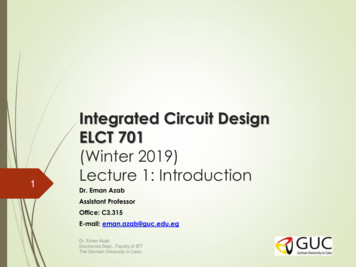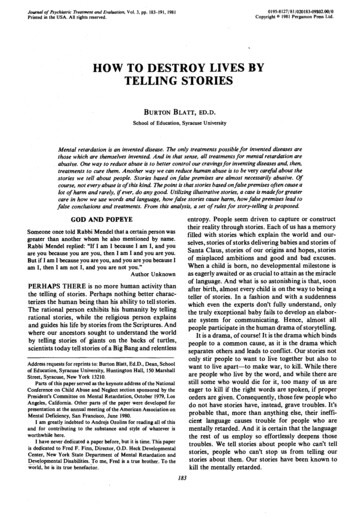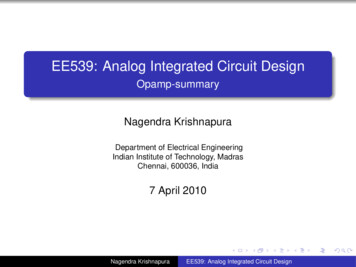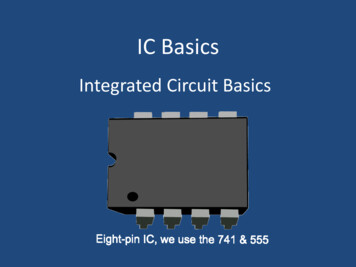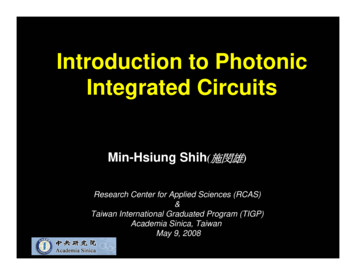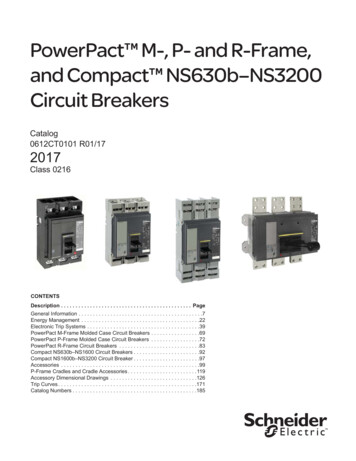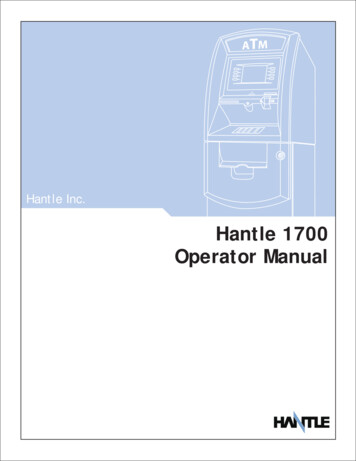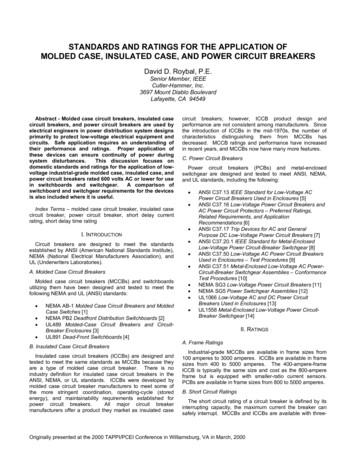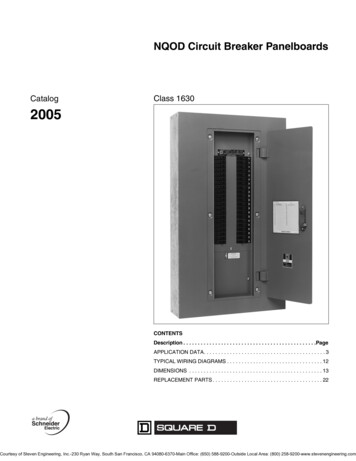
Transcription
Who Invented theIntegrated Circuit?Gene FreemanIEEE Pikes Peak RegionLife MemberMay 2020Gene FreemanMay 2020
Kilby andNoycePhotos(Kilby, TI Noyce, Intel)Gene FreemanMay 2020
Commemorative Microchip StampGene FreemanMay 2020Image:ComputerStamps.com
MotivationGene FreemanMay 2020
Trav-ler 4 Tube Tabletop AM Radio around 1949Gene FreemanMay 2020
Discretepassivesand point topoint wiringGene FreemanMay 2020
Motivators Computers Space vehicles Decrease power, space, cost Increase reliabilityGene FreemanMay 2020
Tyranny ofNumbers In an article celebrating the tenth anniversary of theinvention of the computer, J. A. Morton, A VicePresident of Bell Labs wrote in Proceedings of theIRE in 1958: “For some time now, electronic man has known how'in principle' to extend greatly his visual, tactile, andmental abilities through the digital transmission andprocessing of all kinds of information. However, allthese functions suffer from what has been called'the tyranny of numbers.' Such systems, because oftheir complex digital nature, require hundreds,thousands, and sometimes tens of thousands ofelectron devices. Each element must be made,tested, packed, shipped, unpacked, retested, andinterconnected one-at-a-time to produce a wholesystem.”Gene FreemanMay 2020
Solutionelements Active Components: VacuumTubes to transistors Passive Components: Discreteto integrated form Wires to integrated wiresGene FreemanMay 2020
Key Companies in the Story192519561968Bell Labs – Western Electric and AT&Tconsolidate research activities of BellSystem. William Shockley, John Bardeenand Walter Brattain invented thetransistor here December 23, 1947Shockley Semiconductor Laboratory –Started by William Shockley in 1956(Division of Beckman Instruments).Never recovered from Traitorous 8leaving. Sold to ITT in 1968 then closed.Intel- Formed 1968By Robert Noyce and Gordon MooreTexas Instruments- Founded 1930 asGeophysical Service Incorporated.Became Texas Instruments in 1951.Fairchild Semiconductor – Formed 1957–Led to creation of Intel and AMD19301957Gene FreemanMay 2020
Traitorouseight Gordon Moore (Moore’s Law) Intel CoFounder Sheldon Roberts Eugene Kleiner, founder of Kleiner Perkins Robert Noyce, Co founded FairchildSemiconductor 1957 and Intel 1968 Victor Grinich Julius Blank Jean Hoerni, developed the Planar Process,key for Xistors and ICs Jay LastGene FreemanMay 2020
Shockley and theTransistorGene FreemanMay 2020
Transistor Timeline194719511948Bardeen andBrattain FilePoint ContactTransistorPatent June17JunctionTransistorPatentGranted09/25/1951US 2,569,347Shockleyfiles junctionTransistorPatent June26, 481950Bardeen,BrattainPoint ContactTransistorPatent GrantGene FreemanMay 20201954TI firstcommercialsilicon XistorTI900 series19511956Bell LabsM1752:GermaniumNPN GrownJunction(1951)Nobel PrizePhysicsTransistor –Shockley,Bardeen,Brattain
Gene FreemanMay 2020Source: Slideshare.net
Source: thebronxchronicle.comGene FreemanMay 2020
The Integrated CircuitGene FreemanMay 2020
Integrated Circuit Invention1952 Concept- Drummer“WirelessElectricalCircuits”1959 NoyceMonolithicIdea, 1/19591958 KilbyMonolithicIdea,07/24/1958Grant Kilby6/23/1964 USPatent No.3,138,743MiniaturizedElectronicCircuitsNoyce files7/30/1959Kilby files2/6/1959Gene FreemanGrant Noyce4/25/1961: USPatent No.2,981,877SemiconductorDevice andLead StructureMay 2020
EarliestReference toIC Challenge Jack Morton, head of transistormanufacturing at Bell Telephone Laboratories,described an early conception of such acircuit. In a 1949 internal report he noted:“Imagine a technique in which theconnecting leads and passive elements are‘printed’ in one continuous fabricationprocess. We do not know the technology ofdoing these things Here then is thechallenge.”Gene FreemanMay 2020
Drummer – WirelessElectrical CircuitsGene FreemanMay 2020
GeoffreyDrummer –WirelessElectricalCircuits Ran a testing group at the TelecommunicationsResearch Establishment at Malvern, England “Wireless”: meant not a radio but electrical circuitsfree of connecting wires and soldered joints May 1952. At the Symposium on Progress in QualityElectronic Components, held in Washington DC hesaid: ‘It seems now possible to envisage electronicequipment in a solid block with no connecting wires.The block may consist of layers of insulating,conducting, rectifying, and amplifying materials, theelectrical functions being connected directly bycutting out areas of the various layers" Drummer failed to get financing from hisgovernment for the work to implement the idea.Gene FreemanMay 2020
Kilby and TexasInstrumentsGene FreemanMay 2020
Jack Kilby TimelineBorn19231958Wentto TIforScale1947 Science19671stHandheldCalculator2000NobelPrize inPhysicsMO1950BSEE1947U of I,MSU ofW1952AttendedBell Labsseminaron XistorsFeb1959FiledICPatent1978 to1984 EEProfessoratTexasA and M1950Gene FreemanMay 20201982NationalInventorsHall ofFame2005DeathfromCancer
Original Kilby CircuitGene FreemanMay 2020Source: cnet.com
PatentDrawing ofPhase ShiftOscillatorGene FreemanMay 2020
Jack KilbyInventionPath Integration and Interconnection Integration – All parts of the circuit could bemade from the same material Interconnection – wires could be printedonto the chip as part of the productionprocess. For the proof of concept Kilby integrated allthe circuit components but didn’t have timeto work out the interconnection so heconnected the parts of the chip by hand withgold wires which was not a large scaleproduction solutionGene FreemanMay 2020
Filing onFebruary 6,1959 Worrying RCA was going to apply for a patent , theyneeded a picture of the interconnection solution.Lacking a model they used the demo chip (the“flying wire”) picture. Although the invention has been shown anddescribed in terms of specific embodiments, it willbe evident that changes and modification arepossible which do not in fact depart from theinventive concepts taught herein. “ connections may be provided in other ways. Forexample silicon oxide may be evaporated on thesemiconductor circuit wafer . Material such as goldmay then be laid down on the [oxide] to make thenecessary electrical connections.”Gene FreemanMay 2020
Multivibrator Circuit from 3,138,743 KilbyGene FreemanMay 2020
Noyce and FairchildSemiconductorGene FreemanMay 2020
From intel . comGene FreemanMay 2020
Noyce had recognized the possibility of printingconnecting strips of metal on a chipRobertNoyceInventionPath This was made possible by Jean Hoerni’s inventionof the planar process (filed May 1, 1959), this ledhim to the idea of integration. Spring of 1959 Fairchild engaged in working outdetails of the planar process so Noyce had adescription and drawing of a chip with theinterconnections built right in. 1st part of the application was interconnections Leads could be deposited at the same time and inthe same manner as the components themselves. There were no wires in the pictures .Gene FreemanMay 2020
Photomicrographof Model 2N1613planar transistorSource: spectrum.ieee.orgGene FreemanMay 2020
Gene FreemanMay 2020Noyce’s FirstChipSource: chiphistory.org
Semiconductor Device and Lead Structure –Noyce – Filed July 30, 1959Gene FreemanMay 2020
Patent BattleGene FreemanMay 2020
Legal Battle Timeline5/1962Board ofPatentInterferenceOpens CaseKilby vsNoyce10/1964Fairchildattacks“FlyingWire” andLaid Down vsAdherent to7/28/1964KilbyTestifies withIdea andFiling Date2/24/196711/7/ 1970TI Rebuttsand Boardrules inKilby’s favorSupremeSummer1966 TI andFairchildmeet andcut a crosslicense dealGene FreemanCourtdenies ahearing11/6/1969AppealsCourtReversesagain infavor ofNoyceMay 2020
KilbyInterconnectDescription Connections may be provided in other ways(gold wires thermally bonded was theprimary example) silicon oxide may be evaporated on thesemiconductor circuit wafer through a mask. to cover the wafer completely except atthe points where electrical contact is to bemade Electrically conducting material such asgold may then be laid down on theinsulating material to make the necessaryelectrical circuit connections.Gene FreemanMay 2020
In brief, the present invention utilizesNoyceInterconnectDescription Dished junctions extending to the surface of thebody of extrinsic semiconductor Insulating surface layer consisting essentially ofoxide of the same semiconductor extendingacross the junctions Leads in the form of vacuum-deposited orotherwise formed metal strips extending overand adherent to the insulating oxide layer formaking electrical connections to and betweenvarious region of the semiconductor bodywithout shorting the junctionsGene FreemanMay 2020
Legal Battle Timeline5/1962Board ofPatentInterferenceOpens CaseKilby vsNoyce10/1964Fairchildattacks“FlyingWire” andLaid Down vsAdherent to7/28/1964KilbyTestifies withIdea andFiling Date2/24/196711/7/ 1970TI Rebuttsand Boardrules inKilby’s favorSupremeSummer1966 TI andFairchildmeet andcut a crosslicense dealGene FreemanCourtdenies ahearing11/6/1969AppealsCourtReversesagain infavor ofNoyceMay 2020
US Supreme Court Kilby was denied. 10 years and 10months after Kilby applied for his patent , Noyce won .however Resolution ofthe Dispute In the 10 years while the case was litigated, IC s wererecognized as the most important new product in thehistory of electronics. By the time the courts resolvedthe issue ICs were a multi-billion dollar industry. Summer of 1966 a deal was cut. TI and Fairchild crosslicensed each other Any other firm had to arrangelicenses with both. Generally the royalty was 2-4 % ofthe licensee’s profit from chip production. Both Kilby and Noyce inducted into National InventorsHall of Fame. Kilby gets credit for idea of integratingcomponents on a chip and Noyce for practical way tointerconnect them.Gene FreemanMay 2020
Value of theCourt Battle? So hardly anyone paid attention to the finalcourt decision. 10 years, 10K pages, 1M in legal fees, theresult in Electronic News was “patentappeals court finds for Noyce on IC’s” “IC Patent reversal won’t change much”Gene FreemanMay 2020
Nobel Prize in Physics 2000Gene FreemanMay 2020
The Nobel Prize in Physics 2000 was awarded "for basic workon information and communication technology" with onehalf jointly to Zhores I. Alferov and Herbert Kroemer "fordeveloping semiconductor heterostructures used in highspeed- and opto-electronics" and the other half to Jack S.Kilby "for his part in the invention of the integrated circuit."Gene FreemanMay 2020
WorkThe discovery of the small electroniccomponent, the transistor, created newopportunities to amplify and control electricalsignals. New materials were used andtransistors gradually became smaller.Independently of one another, in 1959 JackKilby and Robert Noyce showed that manytransistors, resistors, and capacitors could begrouped on a single board of semiconductormaterial. The integrated circuit, or microchip,came to be a vital component in computers andother electronic equipment.Gene FreemanMay 2020
Kilby Accepts NobelPrize for Physics –December 10, 2000Source: nobelprize.orgGene FreemanMay 2020
To ScaleGene FreemanMay 2020Source: thehindu.com
Source: electronics weekly.comGene FreemanMay 2020
Tom Yeargan’sLetter that wentwith prototypeGene FreemanSource: newatlas.comMay 2020
Some Final Observations When the time is right there is more than one inventor Legal processes take so long that sometimes the businesses moveahead anyway Shockley had leadership positives and negatives but the negativesdominated Kilby was an individual contributor at heart Noyce was an inventor but could scale to the CEO roleGene FreemanMay 2020
References Stan Augarten, Bit by Bit, Ticknor and Fields,1984 George Gilder, Microcosm, Simon andSchuster, 1989 Robert Noyce et al., Microelectronics,Scientific American, W. H. Freeman, 1977 T.R. Reid, The Chip, Random House, 1985 Arjun Saxena, “Monolithic Concept and theInventions of Integrated Circuits by Kilby andNoyce”; NSTI-Nanotech 2007 Robert Somerville, The Chipmakers ,Understanding Computers Series, Time LifeBooks, 1990Gene FreemanMay 2020
Questions and CommentsGene FreemanMay 2020
Circuits 1958 Kilby Monolithic Idea, 07/24/1958 1959 Noyce Monolithic Idea, 1/1959 Kilby files 2/6/1959 Noyce files 7/30/1959 Grant Noyce 4/25/1961: US Patent No. 2,981,877 Semiconductor Device and Lead Structure Grant Kilby 6/23/1964 US Patent No. 3,138,743 Miniaturized Electronic Circuits In

